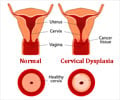Cytology has long been established as an excellent screening tool to prevent cervical cancer by detecting precancerous lesions.

‘Taking a small sample of cells from women at high-risk of cervical cancer could be a cost-effective and accurate strategy for early diagnosis in low and middle income countries.’





But in less developed countries, a lack of
infrastructure and quality management have hampered widespread
implementation of effective screening programs.Taking a small sample of cells from women at high-risk of cervical cancer could be a cost-effective and accurate strategy for early diagnosis in low and middle income countries, according to research led by Queen Mary University of London (QMUL), funded by Cancer Research UK and published in the Journal of Global Oncology.
In the first study to evaluate the use of cytology to diagnose cervical cancer in LMICs, the researchers looked at cytology results from 717 cervical cancers from 23 studies in countries including India, Bangladesh, China, Thailand, Kenya, South Africa, Uganda, Peru, El Salvador, Costa Rica, Nicaragua, Brazil, Argentina and Egypt. They argued that cytology in these countries might be used to diagnose cervical cancer earlier.
The researchers found that even in these low-resource settings, cytology was very sensitive and consistent for detecting invasive cancer. Cytology was found to successfully find cancer with 95.9% accuracy in high-risk women showing symptoms.
Corresponding author Dr Alejandra Castanon from QMUL said: "Cytology has long been established as an excellent screening tool to prevent cervical cancer by detecting precancerous lesions. However, little research has been carried out regarding its sensitivity to cancer."
Advertisement
The researchers say that restricting cytology to symptomatic women and referring only those with severe lesions would lead to substantially fewer women requiring further investigation. This could mean a reduction in burden on resource and cost, and could result in the diagnosis of cervical cancers at an earlier stage to improve overall survival from the disease.
Advertisement
Source-Eurekalert















